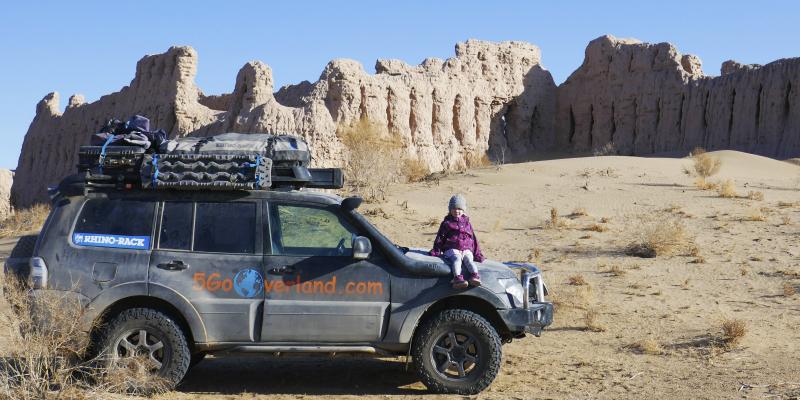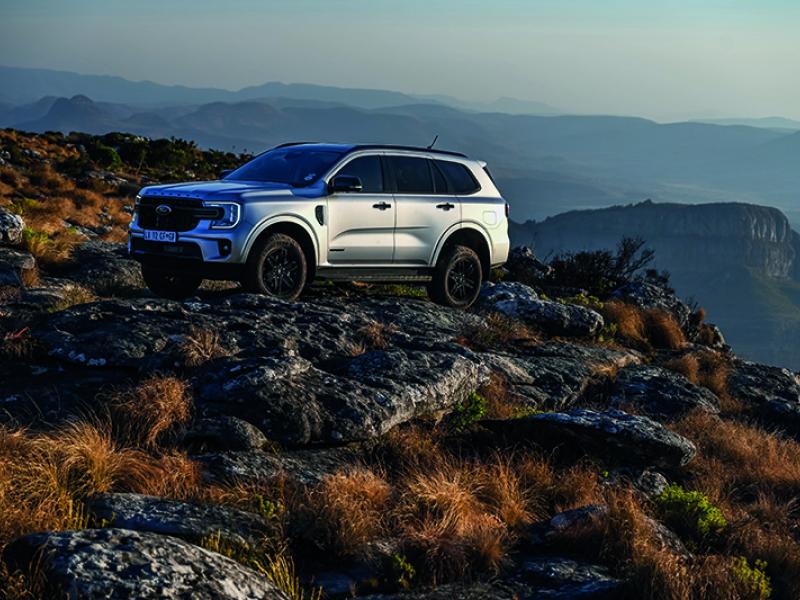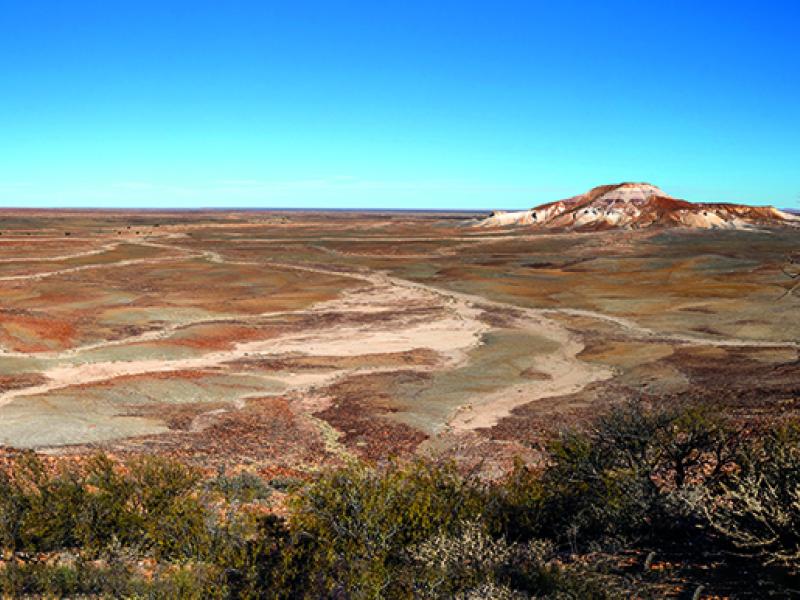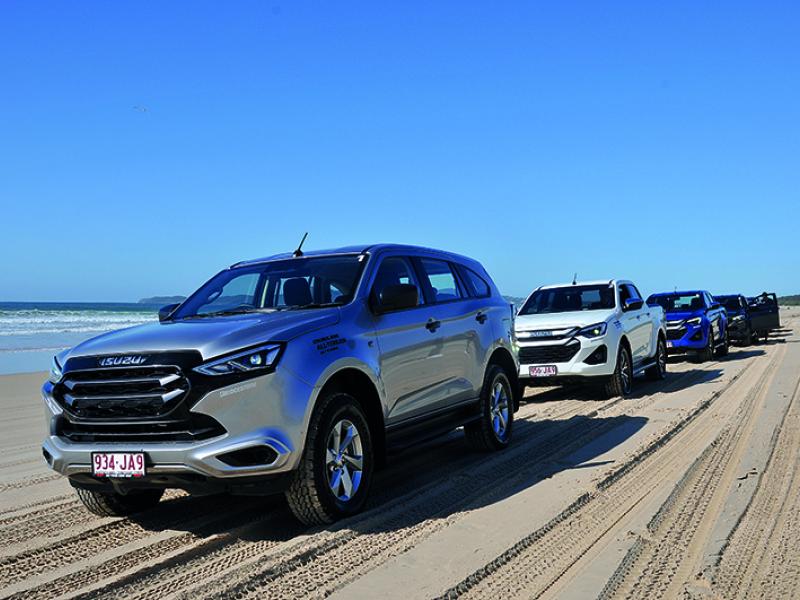Uzbekistan’s inhospitable deserts are home to the ruins of hundreds of ancient fortresses, many – as Overlander Aaron Rich and his family found out – practically accessible only by 4WD!
Across the region of Uzbekistan known as Khorezm, and the autonomous Uzbek republic of Karakalpakstan, many ancient fortresses still stand amidst isolated desert landscapes.
Little known and seldom visited, some of these long-abandoned fortresses are more than 2,000 years old! Uzbekistan's inhospitable deserts swelter in unrelenting summer sun and freeze in cold winters.
As described in the side bar, our visit in late November 2019 was in freezing conditions. In times long since gone by civilisations existed out here and today more than 400 fortresses or ancient monuments remain to be found, scattered around these deserts. One could easily think this area must surely have captured a sizeable amount of archaeological interest, but in fact there has been relatively little. For a time the Soviets paid some attention, but even their interest dwindled and again these ancient fortresses were forgotten about and left alone. And amazingly, there are no restrictions on visiting these largely unexcavated sites. Anyone able to research the coordinates for locations of interest can freely do as I did and navigate between key known sites.
One should consider why people who lived in these ancient times needed to live in such heavily fortified citadels. Although the answer is fairly obvious – it was for their protection – simply knowing this doesn't quite drive home just how severe and brutal the constant threat they lived under really was. Of course, even the thick mud brick walls weren't enough to keep the Mongol hordes out in the 13th century.
But even more than a thousand years before they arrived, some of the fortresses had already fallen victim to other powerful and violent nomads that existed long before Ghengis Khan's time.
My research produced coordinates for a number of ancient sites for us to visit, some of which proved of more interest than others. With this month’s article I'll present a small collection of the best images I captured at my two favourite sites.
Jambas Qala
Jambas (or Janbas) means 'side' or 'flank' and qala (or kala) means 'fort' or 'castle'. So Jambas Qala broadly translates to 'fortress on the side of a hill'. Built around the fourth century B.C. this is believed to be one of the earliest frontier fortresses of Khorezm; it was built soon after this region gained its independence from the first Persian Empire.
Think about that for a moment... fourth century B.C... this fortress is more than 2,000 years old!
Jambas Qala is believed to have once been home to a population of 2,000 people and may have been defended by both men and women. Historians believe that nomadic societies of the time militarily trained both sexes.
This site is believed to have been inhabited only up until the first century A.D. Briefly, there are a couple of competing theories as to what occurred here leading to is abandonment. One theory, based on the large number of metal arrow heads found inside the fortress, contends that a nomadic force breached a wall and the citadel within was destroyed in the ensuing fight. Note the defensive slits in the well-preserved outer walls visible in some photos. Elevated corridors formed between the inner and outer walls can still be walked almost right the way around the perimeter of this fortress. I didn't walk it all admittedly – it's a big site and I was too busy taking photos of the most impressive features!
But Marcel and Anastazja walked right the way around, while Kornelia slowly wandered with Mummy. We were all alone out here.
An archaeological expedition of 1938 investigated Jambas Qala and concluded that the fortress was once surrounded by many small agricultural settlements, complete with fields and irrigation systems. That description sounds far removed from the barren desert surrounds seen in my photos, but this wasn't always only arid desert. Indeed, long ago this region was considered fertile land – even subject at times to flooding. In the first millennium B.C. a lush desert oasis is believed to have existed across much of the area. Consequently, the views seen in my photos are likely very different from what inhabitants of ancient Khorezm and Karakalpakstan's fortified citadels would have woken up to over 2,000 years ago.
Ayaz Qala I
This site features three fortresses in very close proximity, known as Ayaz Qala I, II and III. We explored them all, but here I will present images just from my favourite of these – Ayaz Qala I, which we spent a night at!
Ayaz Qala I was a defensive refuge built atop a large flat topped hill. The hill is only 100 metres high, but high enough to see far across the vast surrounding desert. This fortress was built amidst a desert oasis around the same time as Jambas Qala, in the 4th to 3rd century B.C. Similarly, it was part of a chain of fortresses built to defend agricultural settlements from nomad raids.
We arrived at this site late in the day, choosing to set up camp within the fortress walls in order that we could resume our exploration of this site in the morning light of the following day. The setting sun produced truly amazing colours on the horizon, which I did my best to capture.
I recognise that in a more developed country it could be frowned upon to make camp inside a site like this. As mentioned earlier, these fortresses have been left alone in the desert, without any protections/restrictions, indeed still largely unknown. We follow as environmentally sensitive and responsible practices as possible, taking only photos and leaving only footprints... maybe a puff of diesel particulate matter too... please, no one tell Greta Thunberg!
On the following day, with a clear blue sky overhead, I was able to capture some great images of the many still impressive features to be found around this large fortress. One of my favourite images is the view of nearby Ayaz Qala II, as it can be viewed from Ayaz Qala I, with nothing but expansive desert visible beyond.
Khiva – Once
the biggest Slave
Trading Market in
all of Central Asia
After a day and a half of exploring desert fortresses, and three nights spent camped in various locations out in the desert, we were ready for a dose of civilisation again – this time in Khiva. I tend to think of Khiva as another Silk Road city along with Samarkand and Bukhara, though in fact it is smaller, not quite as old, and located on a side branch of the Silk Road more so than along a major trading route. That said, Samarkand, Bukhara and Khiva are all sufficiently unique that all three are of interest to visit.
Today tourists wander the passageways of Khiva's old town, set within its impressive high defensive walls, marvelling at some truly interesting architecture. But In the not too distant past it certainly wasn't such a pleasant experience here for foreigners, most of whom would have found themselves brought here to be sold in Khiva's bustling slave market!
Bukhara also conducted a lucrative trade in slaves, but Khiva was at the forefront, operating the biggest slave trading market in all of Central Asia for three centuries. Khiva's slave trade thrived between the 16th and 19th centuries and I was surprised by just how recently it was active.
Most of the slaves were Persians or Kurds, but as time went on Russians increasingly venturing near the region, or sailing on the Caspian Sea, became prized slaves who commanded premium prices at market – a Russian male is said to have been worth four camels!
Most slaves were brought to market by fearsome Turkomen raiders, who made their living in this way. To be clear, this wasn't merely a sideline income for the brutal and merciless Turkomen tribes, but rather their adopted way of life. Shackled and often injured, their captives were forcibly marched great distances through the desert towards Khiva. Those who survived the arduous journey, on a diet of little more than chopped straw, were then sold in Khiva's slave market.
Even within the context of the brutality that was commonplace at the time in Khiva, the Turkomen raiders were distrusted and only tolerated there for the lucrative trade in slaves that they supplied.
One foreign visitor to Khiva in 1819 estimated there were 30,000 slaves, including 3,000 Russians. Although the increasing trade in Russians was causing genuine resentment in Russia, the British feared Russia would use this as a pretext to invade Khiva and thereby gain a foothold in Central Asia – much too close to home at the time for the British Empire. It's a longer story than I'll attempt to tell here, but in brief the British decided to get involved to secure the release of Russian slaves – not out of any compassion, but politically motivated and aimed at ending any pretext the Russians would have for invading.
The strategy worked, though delaying rather than preventing Russia's incursions into Central Asia and Afghanistan. Indian born British-Indian Army officer Richmond Shakespear was sent to negotiate with the brutal and merciless Khan of Khiva. In 1840 he succeeded in his mission when he marched 418 freed Russians into the Russian city of Orenburg, just north of the Kazakh border.
Having witnessed the misery of newly captured slaves first-hand, Richmond Shakespear later wrote in his book of the peril of newly enslaved captives:
"Well may they shed tears of anguish, for well they know their fate. Never in their surliest moods did they inflict such cruel treatment on their cattle as they themselves are now doomed to undergo from their fellow creatures; and all hopes of home, or wife, children, and kindred, have vanished like the dreams of the previous night. The rest of their life is doomed to be passed in slavery, amongst people indifferent to human suffering, and unacquainted with mercy."
Ref: Richmond Shakespear 1842 - 'A Personal Narrative of a Journey from Herat to Orenburg, on the Caspian, in 1840'.






